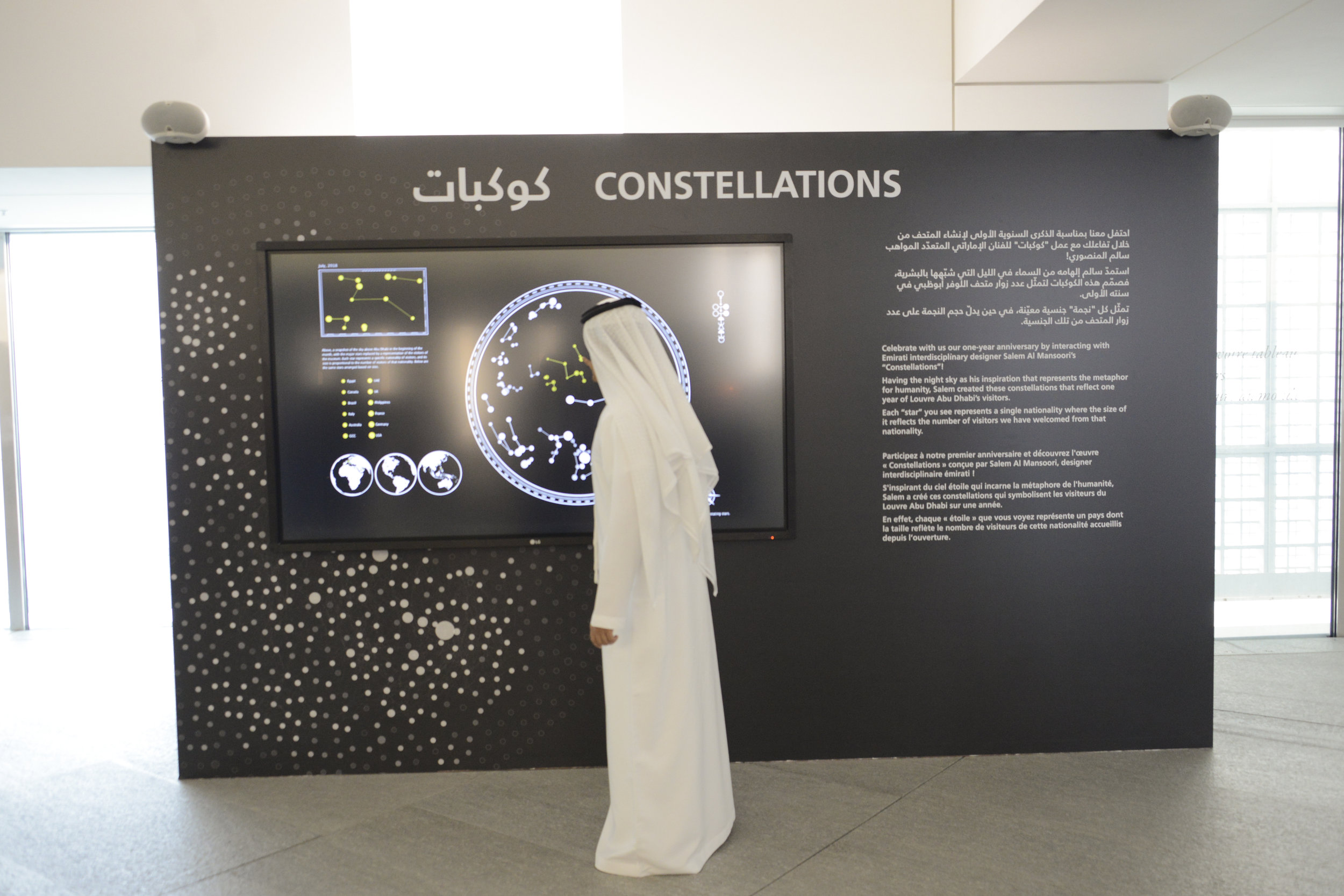How the Louvre Abu Dhabi created a 'night sky' from visitor data
Visitors in front of the Constellations artwork. Courtesy DCTA.
In the lobby of the Louvre Abu Dhabi, during its one-year anniversary celebrations, an animated digital artwork by Emirati interdisciplinary designer Salem Al Mansoori acts as a metaphor for all that the museum has attempted to achieve in its first year of life.
The interactive screen mimics actual sky maps, charting the positioning of stars above Abu Dhabi, month-by-month, for the past year. It then uses a specially formulated digital algorithm to equate each gathering of stars -- or constellation -- to the visitor data from the museum corresponding to that specific month.
The result is a layered digital art-piece consisting of 12 constellations of varying size stars. Each star represents a specific nationality and the size of the star represents the number of visitors from that particular country. The variations within each constellation reflect the fluctuations witnessed over the course of the year.
It is a compelling way to impart otherwise potentially overwhelming information and part of a comprehensive program of workshops, concerts and commissioned artwork serving to mark the museum's first birthday. It also embodies the spirit of universality, which was the museum's original tagline.
Al Mansoori spent several weeks working on the project, which took its inspiration from the building's much lauded architectural structure and its so-called rain of light. "I wanted to respond to the architecture, the dome and the effect when you stand under the dome," he said in a phone interview. "But I also picked up on the symbolic nature of the dome, how it represents the night sky and also how it connects us all."
Traditionally, in Islamic architecture, the dome represents divinity and the idea of heaven, hence its continued use in spiritual buildings. Historically, however, the fascination with the constellations of night sky has differed across geographies.
"Constellations have always been very important to humanity," said Al Mansoori. "They started as navigational aids, to which people later attributed meaning and folklore. The study of the stars in varying regions is one way to document different cultures around the world. It was assumed, at one point that the stars were different in each part of the world and it wasn't until knowledge was standardized that we learned that we were all looking at the same stars from different angles." This, explained the artist, was another reason that he chose to work with the night sky: to set the facts and figures about the Louvre Abu Dhabi's visitors to an interesting visual narrative.
Constellations by Salem Al Mansoori. Image courtesy of Salam Al Mansoori
Since it opened in November 2017, the Louvre Abu Dhabi has welcomed over one million guests with 40% being UAE residents and the rest coming from international locations. Indian nationals make up the largest proportion of visitors, with many of them living in the UAE as well as visiting tourists. Other significant numbers come from France, Germany, China, UK, the USA and from the neighboring Gulf countries.
Perhaps unsurprisingly, Emiratis are the second top nationality and the most often repeat visitors. Al Mansoori said that as he was working his way through the statistics, he felt proud. "It is truly exciting to realize that we have a global institution on our door step. To be able to go there at any time and experience the world-class art and be inspired by all that the museum has to offer is invaluable. It is not just important to us as Emiratis, it is something important to the global landscape."
Being commissioned by the institution to create a data-driven work, was what Al Mansoori describes as "milestone opportunity" in his career. With a background in computer engineering and interest in constructing aesthetic systems that are capable of generating dynamic visual elements, Constellations also talks to a contemporary audience, who are increasingly digitally fluent.
"The idea of using computation in general when producing art is under-utilized specifically in our region," he said. "Personally, it is essential to consider the consumer and to invite them to be involved in the work."
As such, Constellations is also equipped with an audio element, meaning that each star or nationality is assigned a different musical note. Then, when a user clicks on one specific constellation, or calendar month, a tune will play depending on the order of the stars. Because this changes with every month, the sounds played will vary.
"I try to create memories so that sometime along the line they will remember a specific sensation and remember the experience. I think this is a good thing to aspire to."
Louvre Abu Dhabi, Saadiyat Cultural District, Abu Dhabi. Tel: (600) 565566.



